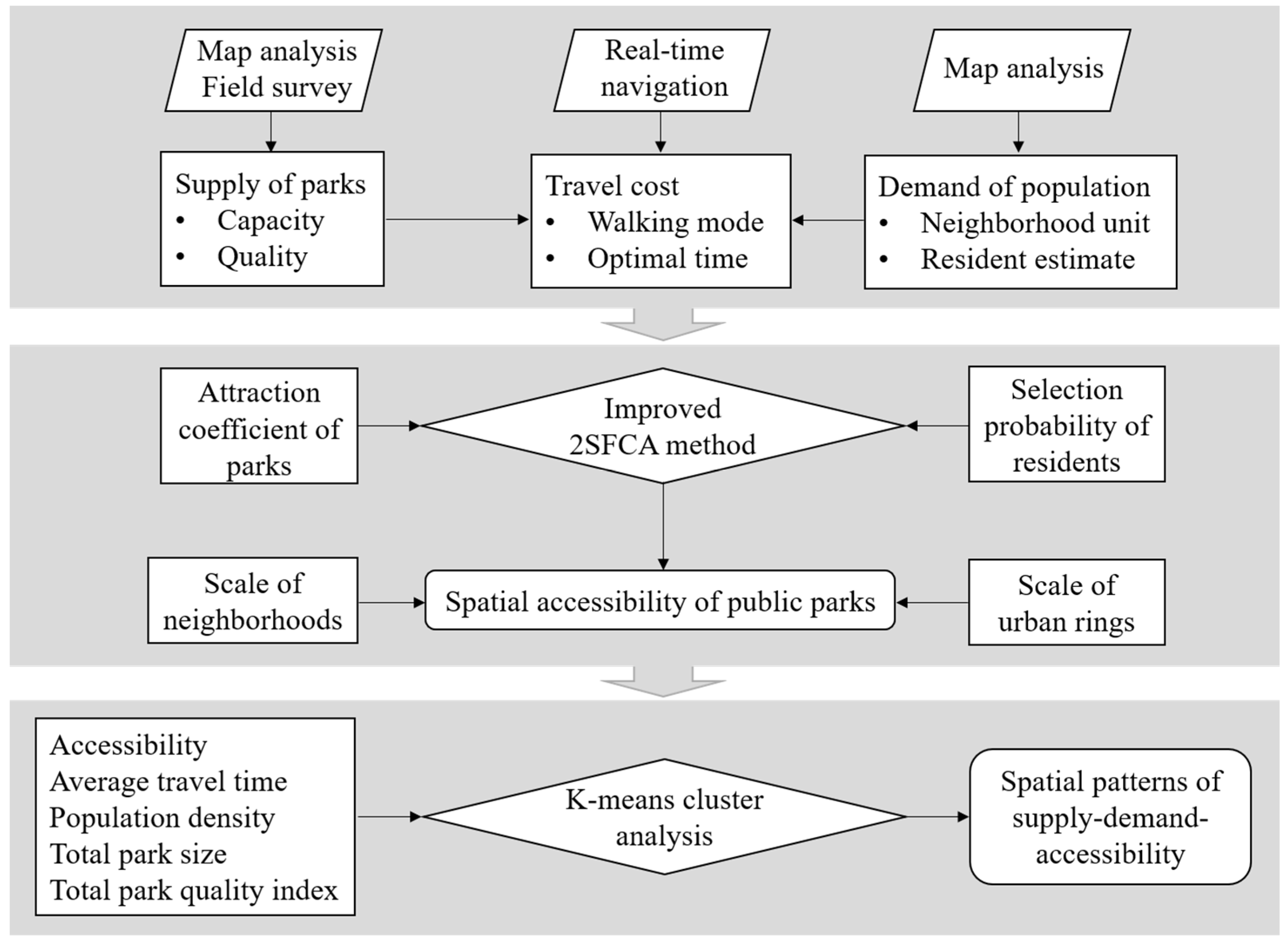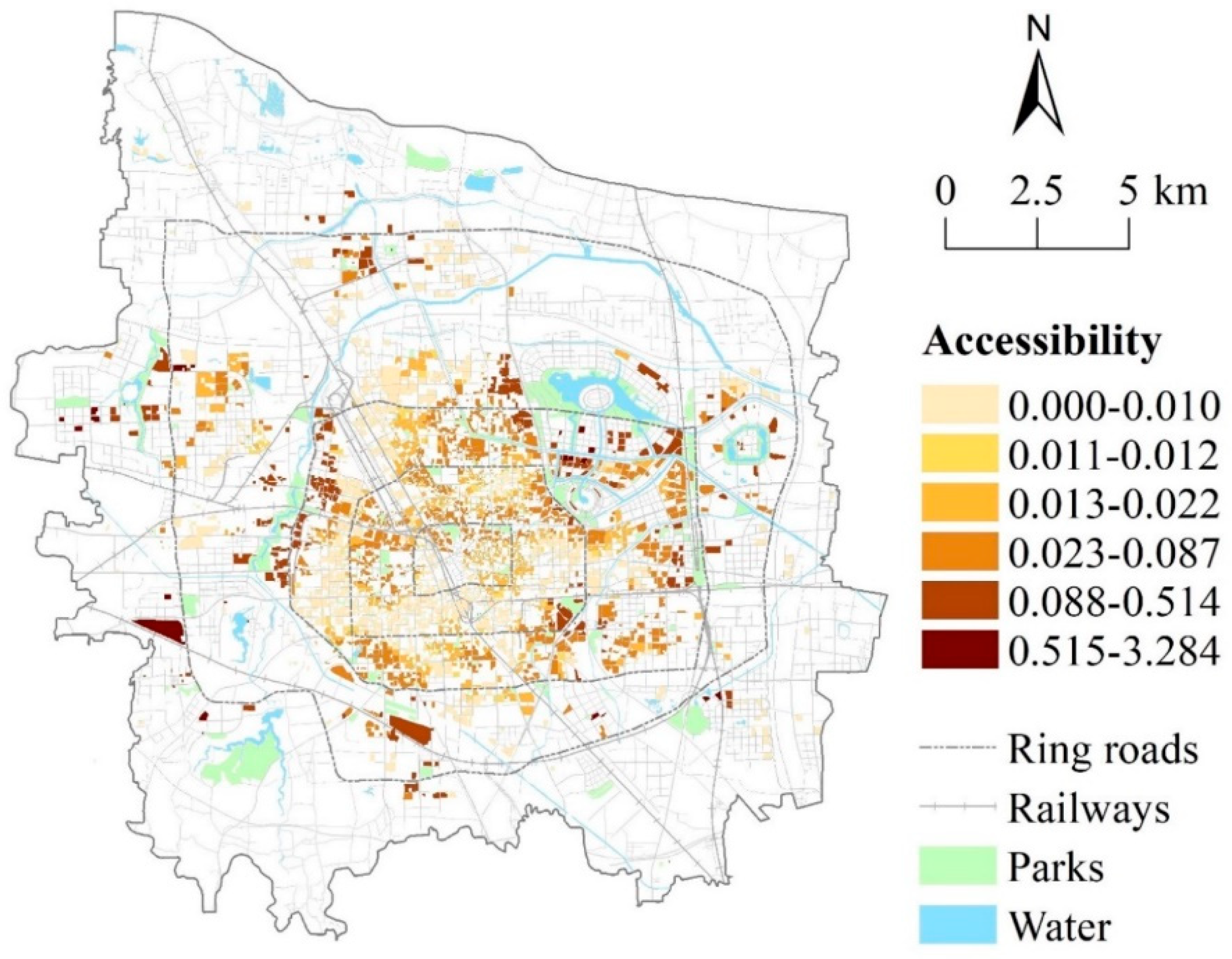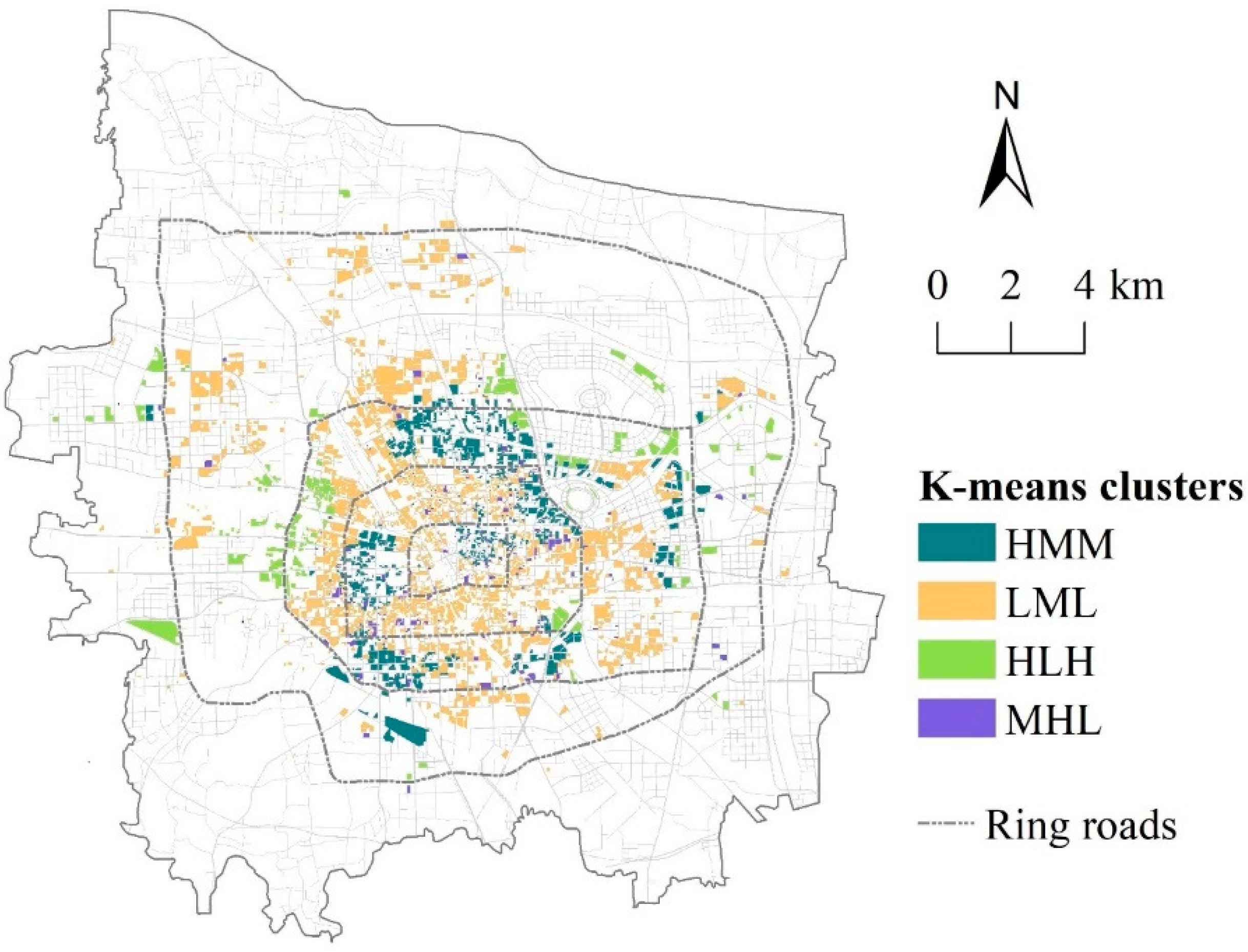Equity Study on Urban Park Accessibility Based on Improved 2SFCA Method in Zhengzhou, China
Abstract
:1. Introduction
2. Literature Review
2.1. Accessibility Measurements
- Buffer analysis method [37] and network-constrained service area method [38], using a predefined distance/time as the search radius to identify the population covered by a particular public facility or to calculate the number/size of public facilities accessible to a specific location. They implicitly assume that public facilities are equally enjoyed within the covering range, which is not true. In addition, it has difficulty determining the threshold distance/time, especially when distinguishing between different types of public facilities. Furthermore, these accessibility measures lack consideration of residents’ demand.
- The nearest distance method and the minimum cost method [20,25] assume that residents always choose the closest or most convenient public facilities to visit. However, accessibility is not necessarily better, the shorter the distance is from a given area to public facilities. Since residents have other considerations besides proximity, such as a likely preference for parks of better quality and with larger spaces that may nevertheless be further away, the supply factors of public facilities are not properly considered in accessibility measurements.
- Gravity-based model [26,28,39] and two-step floating catchment area method [24,40,41] measure the spatial accessibility by the sum of the possibility of multiple facility choices at each demand location. They incorporate the effects of the size/attraction and spatial friction, but this needs to be estimated based on empirical access behavior. The larger the sum of the potentials, the better the accessibility. Compared with the other two types of methods, such models take into account both supply and demand sides, and thus can more comprehensively reflect residents’ access to public facilities.
2.2. Measuring Access to Parks
2.3. Research Purpose and Contributions
3. Study Area and Data Preparation
3.1. Study Area
3.2. Data Source and Processing
3.2.1. Data on Supply of Parks
3.2.2. Data on Demand of Population
3.2.3. Data on Travel Cost
4. Methodology
4.1. Improved 2SFCA Method
4.2. K-Means Cluster Analysis
5. Results
5.1. Spatial Accessibility based on Improved 2SFCA Method
5.2. Equity Evaluation Based on K-Means Cluster Analysis
6. Discussion
7. Conclusions
Author Contributions
Funding
Data Availability Statement
Acknowledgments
Conflicts of Interest
References
- Fekete, A. Budapesti Nagyparkok akadálymentes kialakításának és biztonságos használatának vizsgálata (Népliget, Városliget, Margitsziget). 4d J. Landsc. Archit. Gard. Art 2012, 69–79. [Google Scholar]
- Nesbitt, L.; Meitner, M.J.; Girling, C.; Sheppard, S.R.; Lu, Y.H. Who has access to urban vegetation? A spatial analysis of distributional green equity in 10 US cities. Landsc. Urban Plan. 2019, 181, 51–79. [Google Scholar] [CrossRef]
- Raffestin, C. Territoriality: A reflection of the discrepancies between the organization of space and individual liberty. Int. Political Sci. Rev. 1984, 5, 139–146. [Google Scholar] [CrossRef]
- Ruggeri, D.; Young, D. Community in the information age: Exploring the social potential of web-based technologies in landscape architecture and community design. Front. Archit. Res. 2016, 5, 15–26. [Google Scholar] [CrossRef] [Green Version]
- Sharifi, F.; Nygaard, A.; Stone, W.M.; Levin, I. Accessing green space in Melbourne: Measuring inequity and household mobility. Landsc. Urban Plan. 2021, 207, 104004. [Google Scholar] [CrossRef]
- Van Melik, R.; Van Aalst, I.; Van Weesep, J. Fear and fantasy in the public domain: The development of secured and themed urban space. J. Urban Des. 2007, 12, 25–42. [Google Scholar] [CrossRef]
- Wang, C.; Burris, M.A. Photovoice: Concept, methodology, and use for participatory needs assessment. Health Educ. Behav. 1997, 24, 369–387. [Google Scholar] [CrossRef] [Green Version]
- Weiss, D.J.; Nelson, A.; Gibson, H.; Temperley, W.; Peedell, S.; Lieber, A.; Hancher, M.; Poyart, E.; Belchior, S.; Fullman, N. A global map of travel time to cities to assess inequalities in accessibility in 2015. Nature 2018, 553, 333–336. [Google Scholar] [CrossRef]
- Zhang, J.X.; Hu, Y. A Critique On China’s Urban Renewal From Social Space Justice Viewpoint. Planners 2012, 28, 5–9. [Google Scholar]
- Zhang, R.; Peng, S.J.; Sun, F.Y.; Deng, L.Z.; Che, Y. Assessing the social equity of urban parks: An improved index integrating multiple quality dimensions and service accessibility. Cities 2022, 129, 103839. [Google Scholar] [CrossRef]
- Yang, L.J.; Yang, P.F.; Chen, L. Quantitative Evaluation on the Equity of Park Green Space Provision: A Case Study of Central District of Chongqing. Chin. Landsc. Archit. 2020, 36, 108–112. [Google Scholar] [CrossRef]
- Lefebvre, H. The Production of Space; Blackwell Publishing: Oxford, UK, 1991. [Google Scholar]
- Carmona, M. Place value: Place quality and its impact on health, social, economic and environmental outcomes. J. Urban Des. 2019, 24, 1–48. [Google Scholar] [CrossRef]
- Chiesura, A. The role of urban parks for the sustainable city. Landsc. Urban Plan. 2004, 68, 129–138. [Google Scholar] [CrossRef]
- Forsyth, A. What is a healthy place? Models for cities and neighbourhoods. J. Urban Des. 2020, 25, 186–202. [Google Scholar] [CrossRef]
- Kullmann, K. Grounding landscape urbanism and new urbanism. J. Urban Des. 2015, 20, 311–313. [Google Scholar] [CrossRef] [Green Version]
- Rigolon, A. A complex landscape of inequity in access to urban parks: A literature review. Landsc. Urban Plan. 2016, 153, 160–169. [Google Scholar] [CrossRef]
- Rigolon, A.; Németh, J. A QUality INdex of Parks for Youth (QUINPY): Evaluating urban parks through geographic information systems. Environ. Plan. B Urban Anal. City Sci. 2016, 45, 275–294. [Google Scholar] [CrossRef]
- Tu, X.Y.; Huang, G.L.; Wu, J.G.; Guo, X. How do travel distance and park size influence urban park visits? Urban For. Urban Green. 2020, 52, 126689. [Google Scholar] [CrossRef]
- Boone, C.G.; Buckley, G.L.; Grove, J.M.; Sister, C. Parks and people: An environmental justice inquiry in Baltimore, Maryland. Ann. Assoc. Am. Geogr. 2009, 99, 767–787. [Google Scholar] [CrossRef]
- Fetzer, E.; Ruggeri, D. Landscape Education for Democracy: Methods and Methodology. Landsc. Educ. Democr. 2019, 10, 18–33. [Google Scholar] [CrossRef]
- Sharma, G.; Patil, G.R. Spatial and social inequities for educational services accessibility-A case study for schools in Greater Mumbai. Cities 2022, 122, 103543. [Google Scholar] [CrossRef]
- Xiao, Y.; Wang, Z.; Li, Z.; Tang, Z. An assessment of urban park access in Shanghai—Implications for the social equity in urban China. Landsc. Urban Plan. 2017, 157, 383–393. [Google Scholar] [CrossRef]
- Xing, L.J.; Liu, Y.F.; Wang, B.S.; Wang, Y.H.; Liu, H.J. An environmental justice study on spatial access to parks for youth by using an improved 2SFCA method in Wuhan, China. Cities 2020, 96, 102405. [Google Scholar] [CrossRef]
- Yu, S.Q.; Zhu, X.G.; He, Q. An Assessment of Urban Park Access Using House-Level Data in Urban China: Through the Lens of Social Equity. Int. J. Env. Res. Public Health 2020, 17, 2349. [Google Scholar] [CrossRef] [Green Version]
- McCormack, G.R.; Rock, M.; Toohey, A.M.; Hignell, D. Characteristics of urban parks associated with park use and physical activity: A review of qualitative research. Health Place 2010, 16, 712–726. [Google Scholar] [CrossRef] [PubMed]
- Ben-Elia, E.; Benenson, I. A spatially-explicit method for analyzing the equity of transit commuters’ accessibility. Transp. Res. Part A Policy Pract. 2019, 120, 31–42. [Google Scholar] [CrossRef]
- Chang, H.S.; Liao, C.H. Exploring an integrated method for measuring the relative spatial equity in public facilities in the context of urban parks. Cities 2011, 28, 361–371. [Google Scholar] [CrossRef]
- Dony, C.C.; Delmelle, E.M.; Delmelle, E.C. Re-conceptualizing accessibility to parks in multi-modal cities: A Variable-width Floating Catchment Area (VFCA) method. Landsc. Urban Plan. 2015, 143, 90–99. [Google Scholar] [CrossRef]
- Luo, W.; Qi, Y. An enhanced two-step floating catchment area (E2SFCA) method for measuring spatial accessibility to primary care physicians. Health Place 2009, 15, 1100–1107. [Google Scholar] [CrossRef]
- Hansen, W.G. How accessibility shapes land use. J. Am. Inst. Plan. 1959, 25, 73–76. [Google Scholar] [CrossRef]
- Geurs, K.T.; Van Wee, B. Accessibility evaluation of land-use and transport strategies: Review and research directions. J. Transp. Geogr. 2004, 12, 127–140. [Google Scholar] [CrossRef]
- Vandenbulcke, G.; Steenberghen, T.; Thomas, I. Mapping accessibility in Belgium: A tool for land-use and transport planning? J. Transp. Geogr. 2009, 17, 39–53. [Google Scholar] [CrossRef]
- Rong, P.J.; Zheng, Z.C.; Kwan, M.-P.; Qin, Y.C. Evaluation of the spatial equity of medical facilities based on improved potential model and map service API: A case study in Zhengzhou, China. Appl. Geogr. 2020, 119, 102192. [Google Scholar] [CrossRef]
- Xing, L.J.; Liu, Y.F.; Liu, X.J. Measuring spatial disparity in accessibility with a multi-mode method based on park green spaces classification in Wuhan, China. Appl. Geogr. 2018, 94, 251–261. [Google Scholar] [CrossRef]
- Xu, M.Y.; Xin, J.; Su, S.L.; Weng, M.; Cai, Z.L. Social inequalities of park accessibility in Shenzhen, China: The role of park quality, transport modes, and hierarchical socioeconomic characteristics. J. Transp. Geogr. 2017, 62, 38–50. [Google Scholar] [CrossRef]
- Nicholls, S. Measuring the accessibility and equity of public parks: A case study using GIS. Manag. Leis. 2001, 6, 201–219. [Google Scholar] [CrossRef]
- Miyake, K.K.; Maroko, A.R.; Grady, K.L.; Maantay, J.A.; Arno, P.S. Not just a walk in the park: Methodological improvements for determining environmental justice implications of park access in New York City for the promotion of physical activity. Cities Environ. 2010, 3, 1–17. [Google Scholar] [CrossRef]
- Hillsdon, M.; Panter, J.; Foster, C.; Jones, A. The relationship between access and quality of urban green space with population physical activity. Public Health 2006, 120, 1127–1132. [Google Scholar] [CrossRef]
- Luo, W.; Wang, F.H. Measures of spatial accessibility to health care in a GIS environment: Synthesis and a case study in the Chicago region. Environ. Plan. B Plan. Des. 2003, 30, 865–884. [Google Scholar] [CrossRef] [Green Version]
- Radke, J.; Mu, L. Spatial decompositions, modeling and mapping service regions to predict access to social programs. Geogr. Inf. Sci. 2000, 6, 105–112. [Google Scholar] [CrossRef]
- Wang, F.H. Quantitative Methods and Applications in GIS; CRC Press: Boca Raton, FL, USA, 2006. [Google Scholar]
- Luo, W.; Whippo, T. Variable catchment sizes for the two-step floating catchment area (2SFCA) method. Health Place 2012, 18, 789–795. [Google Scholar] [CrossRef] [PubMed]
- Ibes, D.C. A multi-dimensional classification and equity analysis of an urban park system: A novel methodology and case study application. Landsc. Urban Plan. 2015, 137, 122–137. [Google Scholar] [CrossRef]
- García-Albertos, P.; Picornell, M.; Salas-Olmedo, M.H.; Gutiérrez, J. Exploring the potential of mobile phone records and online route planners for dynamic accessibility analysis. Transp. Res. Part A Policy Pract. 2018, 125, 294–307. [Google Scholar] [CrossRef]
- Chen, B.Y.; Yuan, H.; Li, Q.Q.; Wang, D.G.; Shaw, S.-L.; Chen, H.-P.; Lam, W.H. Measuring place-based accessibility under travel time uncertainty. Int. J. Geogr. Inf. Sci. 2017, 31, 783–804. [Google Scholar] [CrossRef]
- Hao, F.L.; Wang, S.J.; Xie, D.C.; Yu, T.T.; Feng, Z.X. Space-Time Accessibility of Commercial Centers in Changchun Urban Area Based on Internet Map Service. Econ. Geogr. 2017, 37, 68–75. [Google Scholar] [CrossRef]
- Li, S.J.; Ma, S.; Zhang, Y.M. Spatial Patterns of the Mismatch Degree between the Accessibility and the Visiting Preference for All Parks in the Main City of Zhengzhou. Areal Res. Dev. 2019, 38, 79–85. [Google Scholar] [CrossRef]
- Shi, Z.; Xing, L.H.; Zheng, L.L.; Mu, B.; Tian, G.H. Evaluations and optimization strategies of synergy degree of park green space based on balance of supply and demand for recreation. J. Nanjing For. Univ. 2021, 45, 197–204. [Google Scholar] [CrossRef]
- Xing, L.H.; Wang, Y.Q.; Liu, M.S.; Duan, Y.B.; Tian, G.H. Evaluation on balance of park greenspace and residential population distribution in the major urban area of Zhengzhou city. J. Northwest For. Univ. 2020, 35, 258–265. [Google Scholar] [CrossRef]
- Niu, Q.; Zhang, Y.X.; Zhang, W.M.; Wu, L. Accessibility evaluation of large parks in Wuhan based on open map access via network map API and Gaussian two-step mobile search method. In Proceedings of the Smart Planning, Ecological Habitat, Quality Space—2019 China Urban Planning Informatization Annual Conference, Shenzhen, China, 15–19 June 2019; pp. 322–328. [Google Scholar]
- Lyu, F.N.; Zhang, L. Using multi-source big data to understand the factors affecting urban park use in Wuhan. Urban For. Urban Green. 2019, 43, 126367. [Google Scholar] [CrossRef]
- Zhai, Y.J.; Li, D.Y.; Wu, C.Z.; Wu, H.B. Urban park facility use and intensity of seniors’ physical activity—An examination combining accelerometer and GPS tracking. Landsc. Urban Plan. 2021, 205, 103950. [Google Scholar] [CrossRef]
- Dai, D. Racial/ethnic and socioeconomic disparities in urban green space accessibility: Where to intervene? Landsc. Urban Plan. 2011, 102, 234–244. [Google Scholar] [CrossRef]
- Tong, D.; Sun, Y.Y.; Xie, M.M. Evaluation of green space accessibility based on improved Gaussian two-step floating catchment area method: A case study of Shenzhen City, China. Prog. Geogr. 2021, 40, 1113–1126. [Google Scholar] [CrossRef]
- Luo, J. Integrating the huff model and floating catchment area methods to analyze spatial access to healthcare services. Trans. GIS 2014, 18, 436–448. [Google Scholar] [CrossRef]
- Yang, Y.; He, R.Z.; Ning, D.G.; Wang, G.F.; Liu, M.S.; Fekete, A. An Overview of Urban Park Development in Zhengzhou, China. Acta Biol. Marisiensis 2021, 4, 1–13. [Google Scholar] [CrossRef]
- Harnik, P. Urban Green: Innovative Parks for Resurgent Cities; Island Press: Washington, DC, USA, 2010. [Google Scholar]
- Hughey, S.M.; Walsemann, K.M.; Child, S.; Powers, A.; Reed, J.A.; Kaczynski, A.T. Using an environmental justice approach to examine the relationships between park availability and quality indicators, neighborhood disadvantage, and racial/ethnic composition. Landsc. Urban Plan. 2016, 148, 159–169. [Google Scholar] [CrossRef]
- Rigolon, A.; Browning, M.; Jennings, V. Inequities in the quality of urban park systems: An environmental justice investigation of cities in the United States. Landsc. Urban Plan. 2018, 178, 156–169. [Google Scholar] [CrossRef]








| Variables | Description | Score | Weights |
|---|---|---|---|
| Facilities and amenities | Recreational amenities; Service amenities; Management facilities | Excellent as 1; Good as 0.75; Fair as 0.5; Poor as 0.25; Bad as 0 | 0.8421 |
| Water features | Presence of water bodies | Yes as 1; No as 0 | 0.1053 |
| Tree canopy | The ratio of tree coverage | ≥50% as 1; <50% as 0.5 | 0.0526 |
| Factors | Description |
|---|---|
| Accessibility | Accessibility value calculated for each neighborhood by improved 2SFCA method |
| Average travel time | Average travel time to parks within a 30-min walk of each neighborhood |
| Population density | The ratio of the population of each neighborhood to the corresponding neighborhood area |
| Total park size | Total area of parks within a 30-min walk of each neighborhood |
| Total park quality index | Total quality index of parks within a 30-min walk of each neighborhood |
| Mean | Standard Deviation | Below-Average Neighborhoods | Underserved Neighborhoods | |
|---|---|---|---|---|
| Accessibility | 0.038 | 0.119 | 82.18% | 32.78% |
| HMM | LML | HLH | MHL | |
|---|---|---|---|---|
| Neighborhood (numbers) | 997 | 2494 | 228 | 311 |
| Population ratio (%) | 20% | 56% | 11% | 13% |
| Accessibility | −0.00866 | −0.25272 | 3.0144 | −0.15549 |
| Average travel time | −0.1629 | 0.11978 | −0.41835 | −0.13161 |
| Population density | −0.20521 | −0.18257 | −0.34133 | 2.3722 |
| Total park size | 0.39058 | −0.42391 | 3.03554 | −0.07804 |
| Total park quality index | 1.19771 | −0.46355 | −0.15096 | −0.01162 |
Publisher’s Note: MDPI stays neutral with regard to jurisdictional claims in published maps and institutional affiliations. |
© 2022 by the authors. Licensee MDPI, Basel, Switzerland. This article is an open access article distributed under the terms and conditions of the Creative Commons Attribution (CC BY) license (https://creativecommons.org/licenses/by/4.0/).
Share and Cite
Yang, Y.; He, R.; Tian, G.; Shi, Z.; Wang, X.; Fekete, A. Equity Study on Urban Park Accessibility Based on Improved 2SFCA Method in Zhengzhou, China. Land 2022, 11, 2045. https://doi.org/10.3390/land11112045
Yang Y, He R, Tian G, Shi Z, Wang X, Fekete A. Equity Study on Urban Park Accessibility Based on Improved 2SFCA Method in Zhengzhou, China. Land. 2022; 11(11):2045. https://doi.org/10.3390/land11112045
Chicago/Turabian StyleYang, Yang, Ruizhen He, Guohang Tian, Zhen Shi, Xinyu Wang, and Albert Fekete. 2022. "Equity Study on Urban Park Accessibility Based on Improved 2SFCA Method in Zhengzhou, China" Land 11, no. 11: 2045. https://doi.org/10.3390/land11112045
APA StyleYang, Y., He, R., Tian, G., Shi, Z., Wang, X., & Fekete, A. (2022). Equity Study on Urban Park Accessibility Based on Improved 2SFCA Method in Zhengzhou, China. Land, 11(11), 2045. https://doi.org/10.3390/land11112045







